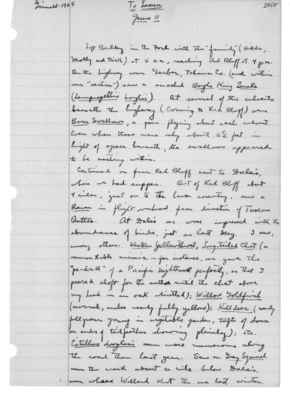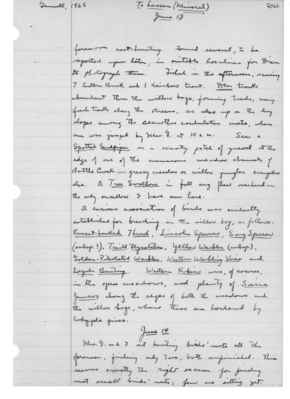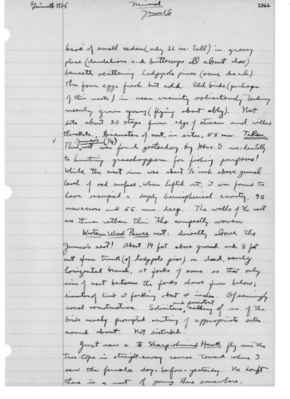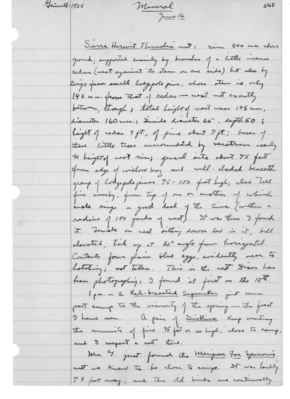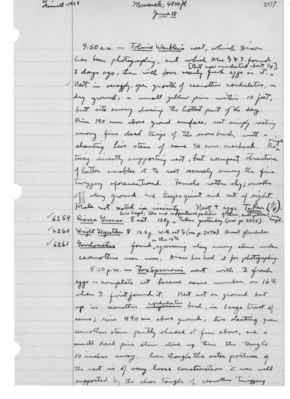Pages That Mention Hilda Grinnell
1925: Joseph Grinnell's field notes
S2 Page 2
Collector: Grinnell - 1925 Location: Lassen Section Date: June 11, 1925 Page Number: 2458
Left Berkeley in the Ford with the "family" (Hilda, Molly and Dick) at 5 a.m., reaching Red Bluff at 4 p.m. on the highway near Gerber, Tehama Co. (and within our "section") saw a smashed Boyle King Snake (Lampropeltis boylii). At several of the culverts beneath the highway (Corning to Red Bluff) were Barn Swallows, a pair flying about each culvert. Even when these were only about 2 1/2 feet in height of space beneath, the swallows appeared to be nesting within. Continued on from Red Bluff east to Dale's, where we had supper. Out of Red Bluff about 4 miles, just on to the lava country, saw a Raven in flight overhead from direction of Tuscan Buttes. At Dale's we were impressed with the abundance of birds, just as last May. I saw, among others: Western Yellowthroat; Long-tailed Chat (a remarkable mimic - for instance, one gave the "pe-ark" of a Pacific nighthawk perfectly, so that I peered aloft for the author until the chat above my head in an oak whistled); Willow Goldfinch (several, males nearly fully yellow); Killdeer (nearly fullgrown young in vegetable garden, tufts of down on ends of tailfeathers showing plainly); etc. Citellus douglasi seem more numerous along the road than last year. Saw an Gray Squirrel near the creek about a mile below Dale's, near where Willard shot the one last winter.
S2 Page 6
Collector: Grinnell - 1925 Location: Lassen Section (Mineral) Date: June 13-14, 1925 Page Number: 2462
forenoon nest-hunting. Found several, to be reported upon later, in suitable locations for Dixon to photograph them. Fished in the afternoon, securing 7 Eastern Brook and 1 Rainbow Trout. Deer tracks abundant thru the willow bogs, forming trails; many fresh tracks along the streams, as also up on the dry slopes among the Ceanothus cordulatus mats, where one was jumped by Mrs. G at 10 a.m. Saw a Spotted Sandpiper on a scanty patch of gravel at the edge of one of the numerous meadow channels of Battle Creek - grassy meadows on willow jungles everywhere else. A Tree Swallow in full song flew overhead - the only swallow I have seen here. A curious association of birds was evidently established for birding in the willow bog, as follows: Russet-backed Thrush, Lincoln Sparrow, Song Sparrow (subsp.?), Traill Flycatcher, Yellow Warbler (subsp.), Golden-Pileolated Warbler, Western Warbling Vireo and Lazuli Bunting. Western Robins were, of course, in the open meadows, and plenty of Sierra Juncos along the edges of both the meadows and the willow bogs, where these are bordered by lodgepole pines. June 14 Mrs. G. and I out hunting birds' nests all the forenoon, finding only two, both unfinished. This seems exactly the right season for finding most small birds' nests; few are sitting yet.
S2 Page 10
Collector: Grinnell - 1925 Location: Lassen Section (Mineral) Date: June 15, 1925 Page Number: 2466
base of small cedar (only 32 in. tall) in grassy place (dandelions and buttercups all about also) beneath scattering lodgepole pines (some dead). The four eggs fresh but cold. Old birds (perhaps of this nests) in near vicinity solicitously tending nearly grown young (flying about ably). Nest sits about 20 steps from edge of stream and willow thickets. Diameter of nest, in situ, 55 mm. Taken. This Junco's (1/4) nest was found yesterday by Mrs. G incidentally to hunting grasshoppers for fishing purposes! While the nest rim was about 1/2 inch above general level of sod surface, when lifted out, it was found to have occupied a deeply hemispherical cavity. 90 mm. across and 55 mm. deep. The walls of the nest are thus rather thin this compactly woven. Western Wood Pewee nest: directly above the Junco's nest! About 14 feet above ground and 7 feet out from trunk (of lodgepole pine) on dead, nearly horizontal branch, at forks of same so that only rim of nest between the forks shows from below; diameter of limb at forking about 4 inches. Of seemingly usual construction. Solicitous and persistent calling of one of the birds nearly prompted scrutiny of appropriate sites round about. Not disturbed. Just saw a male Sharp-shinned Hawk fly over the tree-tops in straight-away course toward where I saw the female day-before-yesterday. No doubt there is a nest of young there somewhere.
S2 Page 12
Collector: Grinnell - 1925 Location: Lassen Section (Mineral) Date: June 16, 1925 Page Number: 2468
Sierra Hermit Thrushes nest: rim 800 mm above ground; supported mainly by branches of a little incense cedar (nest against its stem on one side) but also by twigs from small lodgepole pine, whose stem is only 145 mm. from that of cedar - nest not exactly between, though; total height of nest was 145 mm., diameter 160 mm.; divide diameter 65, depth 50; height of cedar 4 ft., of pine about 7 ft.; bases of these little trees surrounded by veratrum nearly to height of nest rim; general site about 75 fee from edge of willow bog and well-shaded beneath group of lodgepole pines 75-100 feet high; also tall firs nearby, from tip of one or another of which male sings a good deal of the time (within a radius of 100 yards of nest). It was thus I found it. Female on nest sitting down low in it, bill elevated, tail up at 80° angle from horizontal. Contents four plain blue eggs, evidently near to hatching; not taken. This is the nest Dixon has been photographing; I found it first on the 13th. 1 p.m. - a Red-breasted Sapsucker just came past camp to the vicinity of the spring - the first I have seen. A pair of Siskins keep visiting the summit of firs 75 feet or so high, close to camp, and I suspect a nest there. Mrs. G just found the Mariposa Fox Sparrow's nest we knew to be close to camp. It was hardly 75 feet away, and the old birds are continually
S2 Page 22
Collector: Grinnell-1925 Location: Mineral, 4800 ft. Date: June 18, 1925 Page Number: 2477
9:50 am -- Tolmie Warbler's nest, which Dixon has been photographing, and which Mrs. G & I found 3 days ago, then with four nearly fresh eggs in it. ^[But now incubated about 1/4.] Nest in scraggly, open growth of ceanothus cordulatus, in dry ground, a small yellow pine within 10 feet, but site sunny during the hottest part of the day. Rim 190 mm. above ground surface, nest snugly resting among five dead twigs of the snow birch, with a slanting live stem of same 80 mm. overhead. No single twig directly supporting nest, but compact structure of latter enables it to rest securely among the fine twiggery aforementioned. Female rather shy; sneaks off along ground and keeps quiet and out of sight. Male not noted in vicinity. Nest & eggs taken (1/4). 6259 Sierra Grouse (male) nat. 13.8g. ^Iris hazel; toes and unfeathered portions of tarsi, dull yellow; iris hazel. Taken yesterday (see p. 2475). 6260 Wright Flycatcher (female) 12.2g. With set 1/4 (see p. 2476). Breast glandular. 6261 Gerrhonotus found ^on the 16th squirming along among stems under ceanothus near mom; Dixon has had it for photographing. 5:10 p.m. -- Fox Sparrow's nest with 3 fresh eggs -- complete set because same number on 16th when I first found it. Nest not on ground but up in ceanothus integerrimus cordulatus bush, in large tract of same; rim 490 mm. above ground; two slanting green ceanothus stems partly shaded it from above, and a small dead pine stem stood up thru the tangle 10 inches away. Even though the outer portion of the nest is of very loose construction it was well supported by the close tangle of ceanothus twiggery
